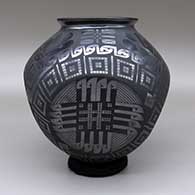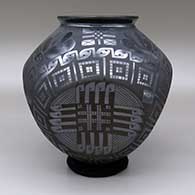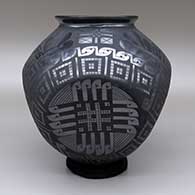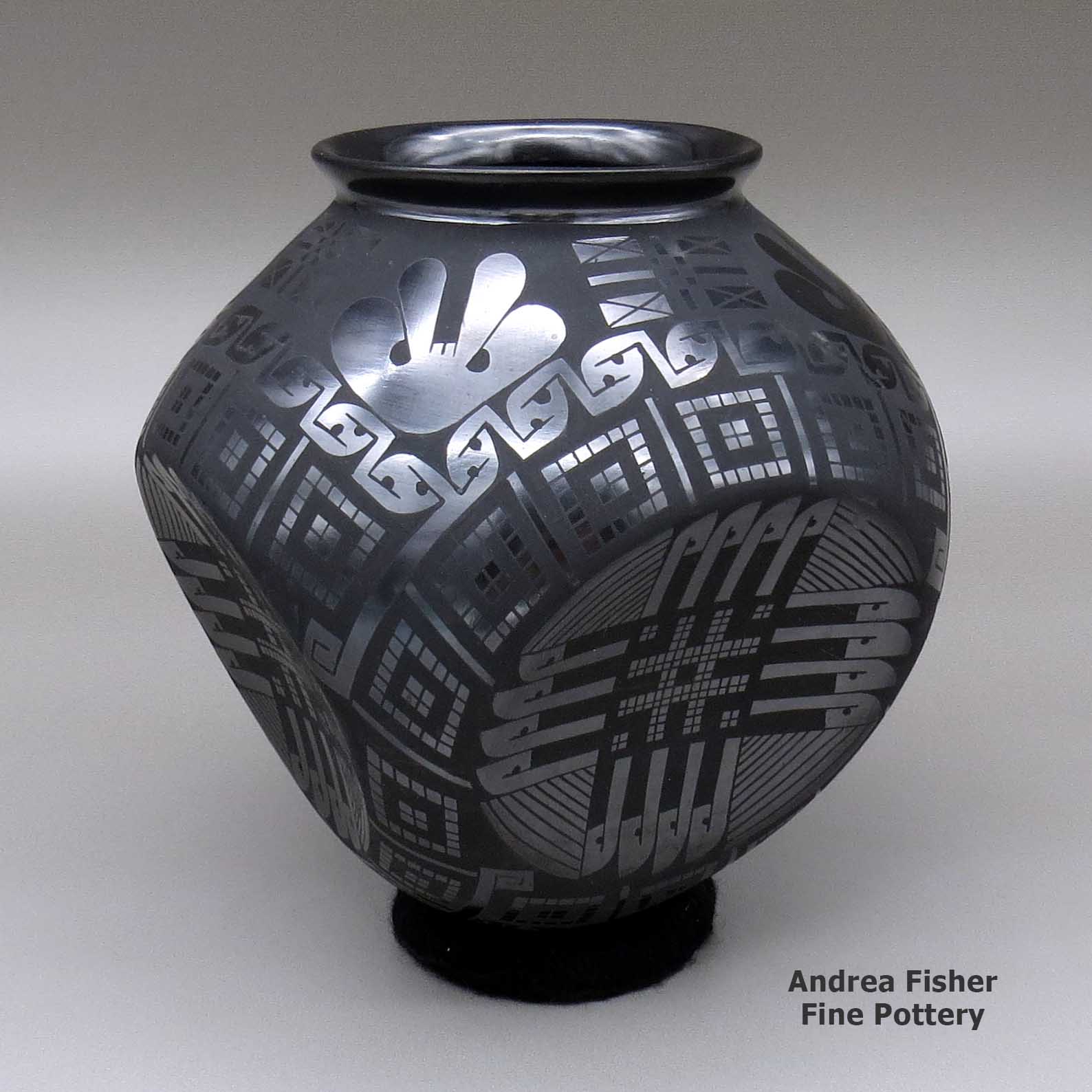
Mata Ortiz and Casas Grandes
$ 995
llcg3g281
Black-on-black jar with a slightly flared opening, a distinctive indented body, and a painted geometric design
8.25 in L by 8.25 in W by 9 in H, measurement includes stand
Condition: Very good, sticker residue on bottom
Signature: E Ortiz
Tell me more! Buy this piece!
(505) 986-1234 - www.andreafisherpottery.com - All Rights Reserved
Eduardo Ortiz
aka Chevo
Mata Ortiz andCasas Grandes
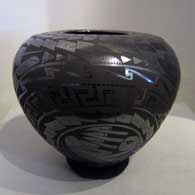
Eduardo "Chevo" Ortiz and his wife, Hortencia Dominguez de Ortiz, were prolific potters until Chevo passed on. Early in their careers they produced a lot of polychrome pottery in Paquimé styles and designs. Later in life, they were known for producing elegant black and black-on-black pottery. Usually, Chevo would make the pots, his wife would sand and polish them, he would paint the basic designs, she would fill in the blanks and he would do the firing.
Chevo was one of the original innovators in Mata Ortiz and was known as one of the best potters in town. He was most famous for producing primarily three kinds of pots:
- Jars with 4 round concave sides highly decorated with cuadritos
- Black jars with pottery rings and some with hooks attached to the rims, as though for hanging
- Black jars with formed melon-like spirals rotating downward from rim to bottom
Andrea visited Mata Ortiz for several days in 2009. Chevo appeared at the dinner held in her honor the last evening she was there. He even wore a shirt. It was one of the only times in his adult life anyone could remember him wearing a shirt, and he'd clearly had to buy one for the occasion. But that's a sign of the respect the Mata Ortiz potters feel for Andrea.
Mata Ortiz and Casas Grandes

The macaw pens at Paquimé
Casas Grandes is both a municipality and an archaeological district in northern Chihuahua State, Mexico. The archaeological district includes the pre-historic ruins of Paquimé, a city that began to build around 1130 AD and was abandoned about 1450 AD. Archaeologists are uncertain as to whether Paquimé was settled by migrants from the Mogollon/Mimbres settlements to the north or by Anasazi elite from the Four Corners region in the United States or by others. Over the years Paquimé was built into a massive complex with structures up to six and seven stories high with multiple Great Houses in the surrounding countryside. Today, the site is a UNESCO World Heritage Site.
Mata Ortiz is a small settlement inside the bounds of the Casas Grandes municipality very near the site of Paquimé. The fortunes of the town have gone up and down over the years with a real economic slump happening after the local railroad repair yard was relocated to Nuevo Casas Grandes in the early 1960's. The town was in steady decline until Juan Quezada, a poor farmer who gathered firewood in the area of the archaeological site, was inspired by fragments of ancient Paquimé pottery and even older fragments of Mimbres forms with bold black-on-white designs littering the ground to learn more.
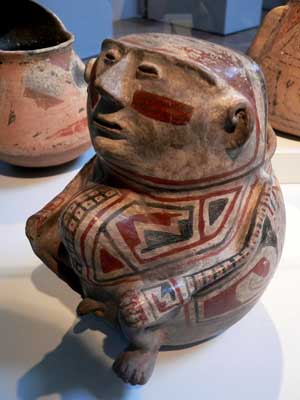
Ramos Polychrome effigy pot from Paquimé
Quezada was successful in his quest to learn to recreate the ancient process using slightly more modern techniques (although no one in the present tradition uses a potter's wheel). He learned to use sand and other coarse materials for temper. He discovered that dried cow dung made an excellent and inexpensive firing fuel. Instead of using gourds for smoothing he substituted broken hacksaw blades. Instead of using yucca fiber brushes for painting he learned to make brushes with human hair. He persevered in his efforts and by 1971 had produced a kind of polychrome pottery. Since then, most pottery-making in the area has used innovations in the design and decoration of the pots but the materials and the basic crafting of the process have remained the same.
By the mid-1970s, Quezada had attracted a significant number of traders and his work was becoming a commercial success. That is when he began teaching his techniques to his immediate family. They in turn taught other family members, friends and the younger generations. Both women and men were included from the beginning.
Originally called Casas Grandes pottery in the early years of its production, the potters of this tiny village have made such an impact on the pottery communities, including many awards and special recognition from the Presidents of Mexico, that Mata Ortiz pottery is now becoming known around the world.
Today, pottery production has changed the village in many ways as there is now electricity, plumbing, vehicles and more for the residents. Virtually everyone in the small town (2010 population: 1,182) makes their living by working in some part of the pottery-making process, from potters to clay-gatherers to firewood collectors to traders.
Mata Ortiz pottery incorporates elements of contemporary and prehistoric design and decoration, and each potter or pottery family produces their own distinctive, individualized ware. Young potters from surrounding areas have been attracted to the Mata Ortiz revival and new potting families have developed while the art movement continues to expand. Without the restraints of traditional religious practices or gender constraints, a vibrant flow of new ideas has enabled the pottery of Mata Ortiz to avoid the derivative repetition common to virtually all folk art movements. This blend of economic need, gender equality, cultural expression and artistic freedom has produced a unique artistic movement in today's community.
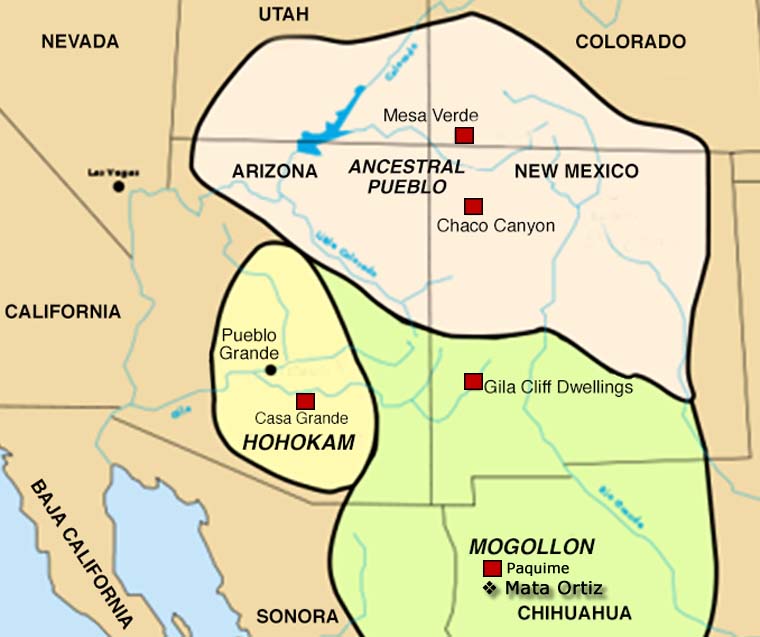
Lower photo is courtesy of David Monniaux, Creative Commons Attribution-Share Alike 3.0 Unported License
Los Hermanos Ortiz Family and Teaching Tree
Disclaimer: This "family and teaching tree" is a best effort on our part to determine who the potters are in this grouping and arrange them in a generational order/order of influence. Complicating this for Mata Ortiz is that everyone essentially teaches everyone else (including the neighbors), so it's hard to get a real lineage of family/teaching. The general information available is scant. This diagram is subject to change as we get better info.
Note: Los Hermanos Ortiz was the name of a music group originally composed of the Ortiz brothers and a few friends who sat in with them from time to time. The group also changed names over the years until, over time, each of the brothers drifted into the art of making pottery full time. Over time they passed that knowledge on to others in their families and in their neighborhoods. But the Ortiz brothers (and father) were among the very first Mata Ortiz potters.
- Santos Ortiz & Bertha Chacon
- Eduardo Chevo Ortiz & Hortencia Dominguez
His students:
- Eduardo Ortiz Jr.
- Eligio Ortiz
- Eusebio Chevo Sandoval & Esperanza Tena
- Israel Sandoval
- Hector Ortega
- Natividad Naty Ortega
- Macario Ortiz & Maria Elena Nena Lopez
- Macaria Ortiz & Gerardo Pedregon
- Julio Cesar Ortiz
- Santos Heder Ortiz
- Tati Eleno Ortiz
- Abigail Gaby Lopez & Pepe Marin
- Eleazar Lopez & Olivia Juarez
- Edmundo Lopez
- Ruben Lozano
- Efrain Lucero
Others who learned from Efrain:
- Cesar Lucero & Miriam Gallegos
- Efrain Lucero Jr. & Elicena Cota
- Maria Elena Ortiz & Raul Navarette
- Cesar Navarette
- Eli Navarette
- Jesus Navarette
- Nicolas Ortiz & Patricia Ortega
- Fabian Ortiz & Rocio Silveira
- Jordi Ortiz
- Miguel Angel Ortiz
- Nicolas Ortiz Jr.
- Osbaldo Ortiz & Theresa Ortiz
- Alonzo Ortiz
- Florence Ortiz
- Salbador Ortiz (d. 1997) & Eduviges Vicki Ortiz
- Paty Ortiz & Cruz Santillan
Some of the above info is drawn from:
- The Many Faces of Mata Ortiz, by Susan Lowell, © 1999, Rio Nuevo Publishers.
- Secrets of Casas Grandes: Precolumbian Art and Archaeology of Northern Mexico, edited by Melissa S. Powell, © 2006, Museum of New Mexico Press.
- Mata Ortiz Pottery Today, by Guy Berger, © 2010, Schiffer Publishing Ltd.
- Mata Ortiz Pottery: Art and Life, by Ron Goebel, © 2008, self-published.
- The Miracle of Mata Ortiz, by Walter P. Parks, © 1993, The Coulter Press.
Most other info is derived from either personal contacts with family members or with individual traders plus interminable searches of the Internet and cross-examinations of the data found.
Copyright © 1998-2024 by


